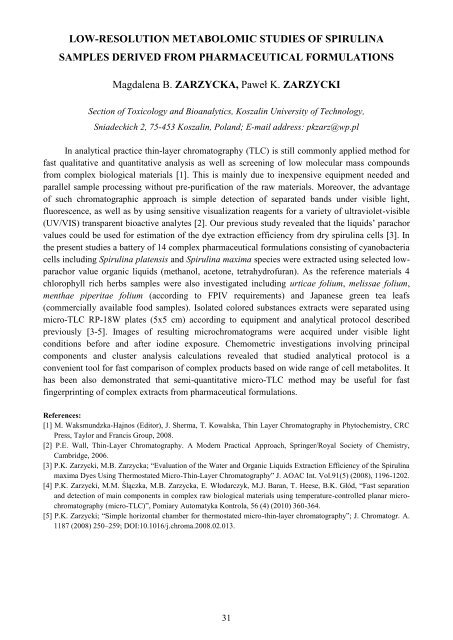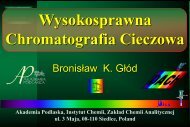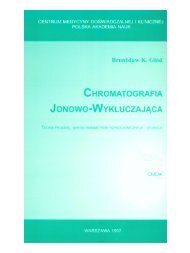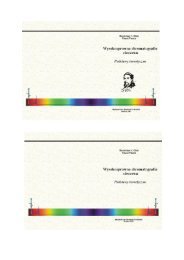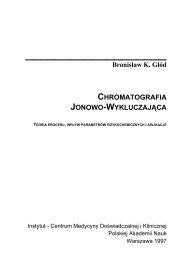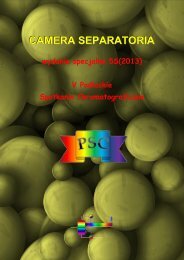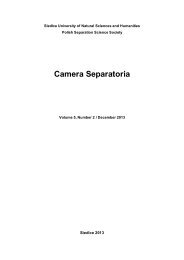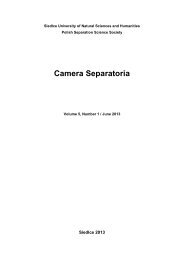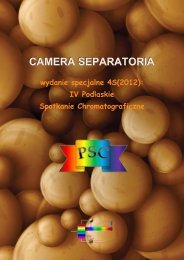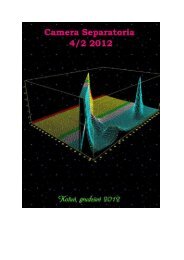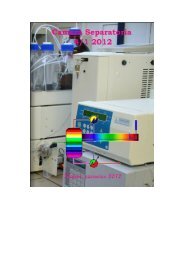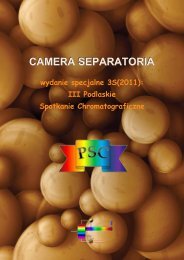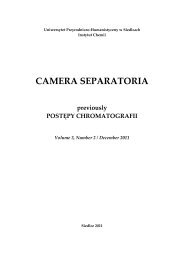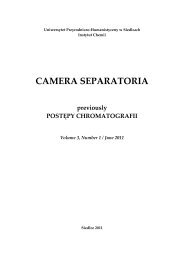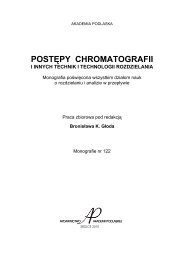CamSep 2 S
You also want an ePaper? Increase the reach of your titles
YUMPU automatically turns print PDFs into web optimized ePapers that Google loves.
LOW-RESOLUTION METABOLOMIC STUDIES OF SPIRULINA<br />
SAMPLES DERIVED FROM PHARMACEUTICAL FORMULATIONS<br />
Magdalena B. ZARZYCKA, Paweł K. ZARZYCKI<br />
Section of Toxicology and Bioanalytics, Koszalin University of Technology,<br />
Sniadeckich 2, 75-453 Koszalin, Poland; E-mail address: pkzarz@wp.pl<br />
In analytical practice thin-layer chromatography (TLC) is still commonly applied method for<br />
fast qualitative and quantitative analysis as well as screening of low molecular mass compounds<br />
from complex biological materials [1]. This is mainly due to inexpensive equipment needed and<br />
parallel sample processing without pre-purification of the raw materials. Moreover, the advantage<br />
of such chromatographic approach is simple detection of separated bands under visible light,<br />
fluorescence, as well as by using sensitive visualization reagents for a variety of ultraviolet-visible<br />
(UV/VIS) transparent bioactive analytes [2]. Our previous study revealed that the liquids’ parachor<br />
values could be used for estimation of the dye extraction efficiency from dry spirulina cells [3]. In<br />
the present studies a battery of 14 complex pharmaceutical formulations consisting of cyanobacteria<br />
cells including Spirulina platensis and Spirulina maxima species were extracted using selected lowparachor<br />
value organic liquids (methanol, acetone, tetrahydrofuran). As the reference materials 4<br />
chlorophyll rich herbs samples were also investigated including urticae folium, melissae folium,<br />
menthae piperitae folium (according to FPIV requirements) and Japanese green tea leafs<br />
(commercially available food samples). Isolated colored substances extracts were separated using<br />
micro-TLC RP-18W plates (5x5 cm) according to equipment and analytical protocol described<br />
previously [3-5]. Images of resulting microchromatograms were acquired under visible light<br />
conditions before and after iodine exposure. Chemometric investigations involving principal<br />
components and cluster analysis calculations revealed that studied analytical protocol is a<br />
convenient tool for fast comparison of complex products based on wide range of cell metabolites. It<br />
has been also demonstrated that semi-quantitative micro-TLC method may be useful for fast<br />
fingerprinting of complex extracts from pharmaceutical formulations.<br />
References:<br />
[1] M. Waksmundzka-Hajnos (Editor), J. Sherma, T. Kowalska, Thin Layer Chromatography in Phytochemistry, CRC<br />
Press, Taylor and Francis Group, 2008.<br />
[2] P.E. Wall, Thin-Layer Chromatography. A Modern Practical Approach, Springer/Royal Society of Chemistry,<br />
Cambridge, 2006.<br />
[3] P.K. Zarzycki, M.B. Zarzycka; “Evaluation of the Water and Organic Liquids Extraction Efficiency of the Spirulina<br />
maxima Dyes Using Thermostated Micro-Thin-Layer Chromatography” J. AOAC Int. Vol.91(5) (2008), 1196-1202.<br />
[4] P.K. Zarzycki, M.M. Ślączka, M.B. Zarzycka, E. Włodarczyk, M.J. Baran, T. Heese, B.K. Głód, “Fast separation<br />
and detection of main components in complex raw biological materials using temperature-controlled planar microchromatography<br />
(micro-TLC)”, Pomiary Automatyka Kontrola, 56 (4) (2010) 360-364.<br />
[5] P.K. Zarzycki; “Simple horizontal chamber for thermostated micro-thin-layer chromatography”; J. Chromatogr. A.<br />
1187 (2008) 250–259; DOI:10.1016/j.chroma.2008.02.013.<br />
31


